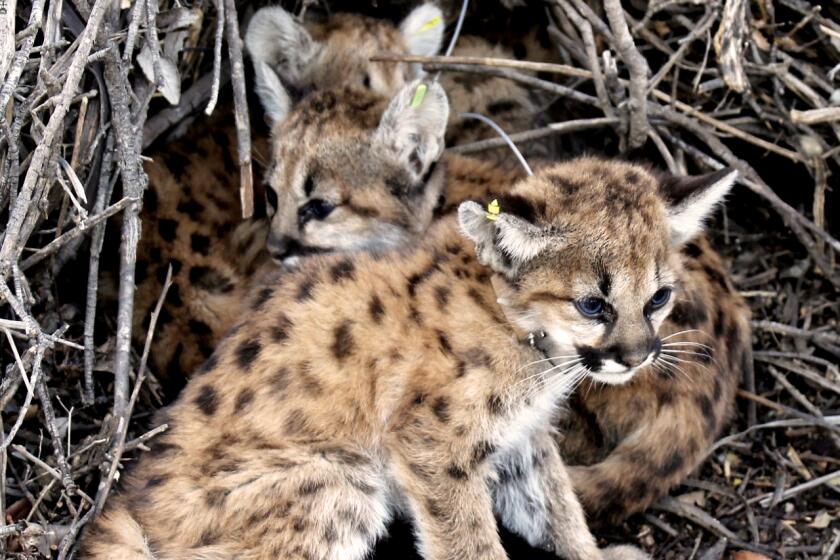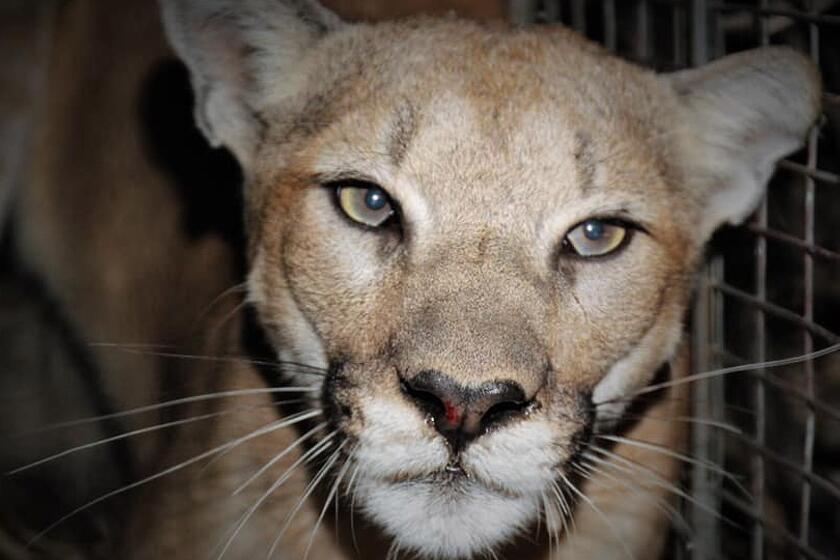Editorial: If we want mountain lions not to become roadkill, they need safe passage across busy roads

- Share via
The young mountain lion ventured out of Decker Canyon in western Malibu and nimbly made his way back and forth across Pacific Coast Highway half a dozen times in the two weeks that biologists tracked him by his radio collar. But on March 23, he made his last attempt. Around 7 a.m. a car hit the lion, dubbed P-104, leaving him dead and bloodied, his entrails spilled out in the middle lane of the fast-moving highway.
Biologists got only a glimpse of the life and habits of P-104, estimated to have been 2 or 3 years old when he was collared on March 8. They now believe he had been feeding for a while on a raccoon carcass stashed on the south side of Pacific Coast Highway.
Mountain lions may top the food chain in the wild, but on a road, the car is the apex predator. Vehicles have mowed down (accidentally, we hope) lions, deer, tortoises, salamanders and other creatures that dare to cross a road in search of food, shelter or a mate.
The short life of P-100 shows again both the resilience and fragility of life for Southern California’s mountain lions.
P-104 was the 104th lion to be entered into the National Park Service’s 20-year-old study of mountain lions. He is also, sadly, the eighth in the study, and 25th mountain lion overall, that biologists have determined were killed by a vehicle in or near the Santa Monica Mountains since 2002. Along with car strikes, the other two leading causes of death for mountain lions in Southern California, according to National Park Service officials, are ingesting rat-poisoned prey and fighting with other lions over territory. Southern California lions are so imperiled that the state is considering giving them protected status under its Endangered Species Act.
One strategy for helping lions and other animals survive is to build wildlife crossings across busy roads and freeways, giving them safe passage from one area to another to find new territory for hunting and breeding.
A new state bill, AB 2344, the Safe Roads and Wildlife Protection Act, authored by Assemblywoman Laura Friedman (D-Glendale) and Assemblyman Ash Kalra (D-San Jose), would direct the Department of Fish and Wildlife and Caltrans to create a list of areas crucial for wildlife movement and other specific locations known to be roadkill hot spots. Any new transportation projects in those places would have to mitigate their impact on wildlife or use the opportunity to fix a spot that is dangerous to cross.
The bill, sponsored by the Center for Biological Diversity and the Wildlands Network, also requires the state to create a wildlife connectivity project list that identifies various places that need some kind of infrastructure such as a crossing, fencing or underpass to make it easier for animals to go over or under a road. Starting in 2026, the state would have to pursue at least 10 of these projects a year. Both state and federal transportation funds are available for wildlife protection projects like these.
P-99, the latest mountain lion to enter the National Park Service study of lions, could have a better future when a wildlife crossing in L.A. County is built.
The bill lays out a smart plan for making it easier not just for mountain lions but for numerous species to find their way across a state landscape fragmented by roads and highways. Not every crossing must be as pricey as the $87-million Wallis Annenberg Wildlife Crossing — a state-of-the-art wildlife bridge over an eight-lane stretch of the 101 Freeway at Liberty Canyon in Agoura Hills that breaks ground this month and is being built with private and public funds. Many projects could require only fencing or a ramp to a culvert.
It’s an investment of public money, to be sure. But these collisions are costly in other ways as well. The Road Ecology Center at UC Davis has estimated the total cost of reported collisions between large wildlife (such as mule deer, bears and mountain lions) and vehicles in California to be at least $1 billion in damage from 2016 to 2020. And the damage isn’t limited to cars. In 2018 alone, the bill states, “at least 314 people were injured and five people were killed in California in vehicle collisions with wildlife.”
The bill also requires monitoring with tracking cameras or other methods — for example, to see if wildlife are using the crossings. That’s good. We will want to be sure that these projects are working. Studies show that areas of other states that have installed crossings have had “dramatic reductions in vehicle-wildlife collisions,” according to J.P. Rose, a senior attorney for the Center for Biological Diversity.
If we want to share the blended landscape of wild and urban that makes Southern California so extraordinary, we have to make it easier and safer for mountain lions to safely cross the road.
More to Read
A cure for the common opinion
Get thought-provoking perspectives with our weekly newsletter.
You may occasionally receive promotional content from the Los Angeles Times.











